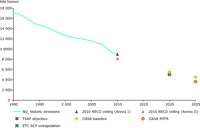
The figure shows the trends for air pollution - particulate matter (PM2.5)

The figure shows the trends for air pollution - Nox

The figure shows the trends for air pollution - NMVOCs

The figure shows the trends for air pollution - NH3

The figure shows development of primary energy consumption and predicton of future consumption

Overview of non-binding targets in EU environmental policies

People of low social status can be more heavily exposed to traffic and traffic-related air pollutants than
people of a higher social status.

Projected chemicals production by region (in sales) Baseline 2010–2050.
China is included in the BRIICS data, but has also been singled out to show its share in the BRIICS projected chemical production.

The figures shows the level of PCB in
A) Grey seals
B) White-tailed sea eagle eggs
C) Guillemot eggs
D) Baltic Herring
in the Baltic region between 1970 and 2010

The red dots indicate stations reporting exceedances of
the 2005 annual limit value (40 μg/m3), as set out in
the Air Quality Directive.
The orange dots indicate stations reporting
exceedances of a statistically derived level (31 μg/m3)
corresponding to the 24–hour limit value, as set out in
the Air Quality Directive.
The pale green dots indicate stations reporting
exceedances of the WHO air quality guideline for PM10
of less than 20 μg/m3 but not in exceedance of limit
values as set out in the Air Quality Directive.
The dark green dots indicate stations reporting
concentrations below the WHO air quality guideline for
PM10 and implicitly below the limit values as set out in
the Air Quality Directive.

The figures show the amount of Waste Electrical and Electronic Equipment (WEEE) that has been collected from private households in European countries, stated in kg/capita. The figures are related to the EU collection target of 4 kg/capita/year. Values are related to 2006, 2008 and 2010.

The figure shows the trend in the amount of WEEE that has been reused and recycled in European countries, stated in kg/capita.

The figure shows the amount of electrical and electronic equipment (EEE) that has been put on the market, and waste electrical and electronic equipment (WEEE) collected in total, collected from private households and reused and recycled in European countries, stated in kg/capita. The figures are related to the collection target of 4 kg/capita/year. Values are related to 2010.